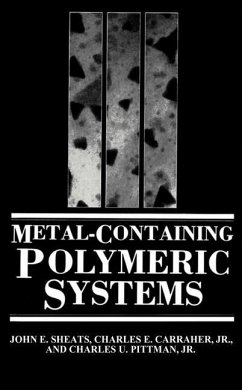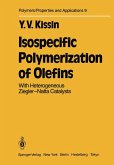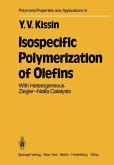- Broschiertes Buch
- Merkliste
- Auf die Merkliste
- Bewerten Bewerten
- Teilen
- Produkt teilen
- Produkterinnerung
- Produkterinnerung
Research on metal-containing polymers began in the early 1960's when several workers found that vinyl ferrocene and other vinylic transition metal u -com plexes would undergo polymerization under the same conditions as conventional organic monomers to form high polymers which incorporated a potentially reactive metal as an integral part of the polymer structures. Some of these materials could act as semi-conducters and pos sessed one or two dimensional conductivity. Thus appli cations in electronics could be visualized immediately. Other workers found that reactions used to make simple metal…mehr
Andere Kunden interessierten sich auch für
![Organic Fluorine Chemistry Organic Fluorine Chemistry]() Milos HudlickyOrganic Fluorine Chemistry39,99 €
Milos HudlickyOrganic Fluorine Chemistry39,99 €![Isospecific Polymerization of Olefins Isospecific Polymerization of Olefins]() Y. V. KissinIsospecific Polymerization of Olefins148,99 €
Y. V. KissinIsospecific Polymerization of Olefins148,99 €![Inclusion Phenomena in Inorganic, Organic, and Organometallic Hosts Inclusion Phenomena in Inorganic, Organic, and Organometallic Hosts]() J.L Atwood / J.E. Davies (Hgg.)Inclusion Phenomena in Inorganic, Organic, and Organometallic Hosts104,99 €
J.L Atwood / J.E. Davies (Hgg.)Inclusion Phenomena in Inorganic, Organic, and Organometallic Hosts104,99 €![Advances in Metal Carbene Chemistry Advances in Metal Carbene Chemistry]() U. Schubert (Hrsg.)Advances in Metal Carbene Chemistry154,99 €
U. Schubert (Hrsg.)Advances in Metal Carbene Chemistry154,99 €![Isospecific Polymerization of Olefins Isospecific Polymerization of Olefins]() Y. V. KissinIsospecific Polymerization of Olefins77,99 €
Y. V. KissinIsospecific Polymerization of Olefins77,99 €![The Barbier Reaction and Related One-Step Processes The Barbier Reaction and Related One-Step Processes]() Cornelis BlombergThe Barbier Reaction and Related One-Step Processes39,99 €
Cornelis BlombergThe Barbier Reaction and Related One-Step Processes39,99 €![Principles of Polymer Chemistry Principles of Polymer Chemistry]() A. RavvePrinciples of Polymer Chemistry79,99 €
A. RavvePrinciples of Polymer Chemistry79,99 €-
-
-
Research on metal-containing polymers began in the early 1960's when several workers found that vinyl ferrocene and other vinylic transition metal u -com plexes would undergo polymerization under the same conditions as conventional organic monomers to form high polymers which incorporated a potentially reactive metal as an integral part of the polymer structures. Some of these materials could act as semi-conducters and pos sessed one or two dimensional conductivity. Thus appli cations in electronics could be visualized immediately. Other workers found that reactions used to make simple metal chelates could be used to prepare polymers if the ligands were designed properly. As interest in homo geneous catalysts developed in the late 60's and early 70's, several investigators began binding homogeneous catalysts onto polymers, where the advantage of homo geneous catalysis - known reaction mechanisms and the advantage of heterogeneous catalysis - simplicity and ease of recovery of catalysts could both be obtained. Indeed the polymer matrix itself often enhanced the selectivity of the catalyst.
Produktdetails
- Produktdetails
- Verlag: Springer / Springer US / Springer, Berlin
- Artikelnr. des Verlages: 978-1-4615-9417-8
- Softcover reprint of the original 1st ed. 1985
- Seitenzahl: 536
- Erscheinungstermin: 12. Dezember 2012
- Englisch
- Abmessung: 244mm x 170mm x 29mm
- Gewicht: 914g
- ISBN-13: 9781461594178
- ISBN-10: 1461594170
- Artikelnr.: 39500322
- Verlag: Springer / Springer US / Springer, Berlin
- Artikelnr. des Verlages: 978-1-4615-9417-8
- Softcover reprint of the original 1st ed. 1985
- Seitenzahl: 536
- Erscheinungstermin: 12. Dezember 2012
- Englisch
- Abmessung: 244mm x 170mm x 29mm
- Gewicht: 914g
- ISBN-13: 9781461594178
- ISBN-10: 1461594170
- Artikelnr.: 39500322
Metal - Containing Polymers: An Introduction.- The Synthesis and Polymerization of Vinyl Organometallic Monomers.- Models for Highly Phenylated Transition Metal-Containing Polymers; Derivatives of the Pentaphenylcyclopentadienyl Ligand.- Ferrocene Polymers.- Use of Organometallic Polymers for Pre-Heat Shields for Targets in Inertial-Confinement Nuclear Fusion.- Hydrophilic Macromolecular - Ferricinium Salts - Part I: Preparative and Spectroscopic Features of Selected Mononculear Ferricinium Compounds.- Polymer-Bound Bimetallic Complexes as Surface Reactants on Semiconductor Electrodes.- Synthesis and Properties of Cationic Cyclopentadienyl Iron (II) Moiety on Polystyrene Beads.- Modification of Dextran Through Reaction with Biscyclopentadienyltitanium Dichloride Employing the Interfacial Condensation Technique.- Electron Microsopic Studies of Osmium Carbohydrate Polymers.- Biological Activities of Monomeric and Polymeric Derivatives of cis-Dichlorodiamine- Platinum II.- Structural Characterization of cis-Platinum II Derivatives of Polyethyleneimine as a Model Carrier for Natural Drug Carriers.- Organotin Piezo - and Pyroelectric Polymer Films.- Nuclear Magnetic Resonance as a Probe of Organic Conductors.- Polymer - Metal Complexes for Solar Energy Conversion.- Conducting Organometallic Polymers and Organometallic Complexes Containing M(CO)3 (Diene) Groups.- Polymers Containing Polynuclear Cobalt and Iron Carbonyl Complexes.- Decomposition of Iron Carbonyls in Solid Polymer Matrices: Preparation of Novel Metal-Polymer Composites.- Microemulsion, Surfactant Vesicle and Polymerized Surfactant Vesicle-Entrapped Colloidal Catalysts and Semiconductors: Preparation, Characterization and Utilization.- Metal-Chelate Polymers: Structural/Property Relationships as aFunction of the Metal Ion.- A Study of Cobalt-Containing Polyimide Films.- Polymeric Bipyridines as Chelating Agents and Catalysts.- Alkali Metal Organometallic Polymers: Preparation and Applications in Polymer and Reagent Synthesis.- Synthesis, Characterization and Applications of Rare Earth Metal Ion Chelating Polymers.- Intermolecular Energy Transfer as a Means for the Characterization of Polymeric Lanthanide Complexes in Solution.- Moisture - Crosslinkable Silane-Grafted Polyolefins.
Metal Containing Polymers: An Introduction.- The Synthesis and Polymerization of Vinyl Organometallic Monomers.- Models for Highly Phenylated Transition Metal-Containing Polymers; Derivatives of the Pentaphenylcyclopentadienyl Ligand.- Ferrocene Polymers.- Use of Organometallic Polymers for Pre-Heat Shields for Targets in Inertial-Confinement Nuclear Fusion.- Hydrophilic Macromolecular Ferricinium Salts Part I: Preparative and Spectroscopic Features of Selected Mononculear Ferricinium Compounds.- Polymer-Bound Bimetallic Complexes as Surface Reactants on Semiconductor Electrodes.- Synthesis and Properties of Cationic Cyclopentadienyl Iron (II) Moiety on Polystyrene Beads.- Modification of Dextran Through Reaction with Biscyclopentadienyltitanium Dichloride Employing the Interfacial Condensation Technique.- Electron Microsopic Studies of Osmium Carbohydrate Polymers.- Biological Activities of Monomeric and Polymeric Derivatives of cis-Dichlorodiamine- Platinum II.- Structural Characterization of cis-Platinum II Derivatives of Polyethyleneimine as a Model Carrier for Natural Drug Carriers.- Organotin Piezo and Pyroelectric Polymer Films.- Nuclear Magnetic Resonance as a Probe of Organic Conductors.- Polymer Metal Complexes for Solar Energy Conversion.- Conducting Organometallic Polymers and Organometallic Complexes Containing M(CO)3 (Diene) Groups.- Polymers Containing Polynuclear Cobalt and Iron Carbonyl Complexes.- Decomposition of Iron Carbonyls in Solid Polymer Matrices: Preparation of Novel Metal-Polymer Composites.- Microemulsion, Surfactant Vesicle and Polymerized Surfactant Vesicle-Entrapped Colloidal Catalysts and Semiconductors: Preparation, Characterization and Utilization.- Metal-Chelate Polymers: Structural/Property Relationships as a Function of the Metal Ion.- A Study of Cobalt-Containing Polyimide Films.- Polymeric Bipyridines as Chelating Agents and Catalysts.- Alkali Metal Organometallic Polymers: Preparation and Applications in Polymer and Reagent Synthesis.- Synthesis, Characterization and Applications of Rare Earth Metal Ion Chelating Polymers.- Intermolecular Energy Transfer as a Means for the Characterization of Polymeric Lanthanide Complexes in Solution.- Moisture Crosslinkable Silane-Grafted Polyolefins.
Metal - Containing Polymers: An Introduction.- The Synthesis and Polymerization of Vinyl Organometallic Monomers.- Models for Highly Phenylated Transition Metal-Containing Polymers; Derivatives of the Pentaphenylcyclopentadienyl Ligand.- Ferrocene Polymers.- Use of Organometallic Polymers for Pre-Heat Shields for Targets in Inertial-Confinement Nuclear Fusion.- Hydrophilic Macromolecular - Ferricinium Salts - Part I: Preparative and Spectroscopic Features of Selected Mononculear Ferricinium Compounds.- Polymer-Bound Bimetallic Complexes as Surface Reactants on Semiconductor Electrodes.- Synthesis and Properties of Cationic Cyclopentadienyl Iron (II) Moiety on Polystyrene Beads.- Modification of Dextran Through Reaction with Biscyclopentadienyltitanium Dichloride Employing the Interfacial Condensation Technique.- Electron Microsopic Studies of Osmium Carbohydrate Polymers.- Biological Activities of Monomeric and Polymeric Derivatives of cis-Dichlorodiamine- Platinum II.- Structural Characterization of cis-Platinum II Derivatives of Polyethyleneimine as a Model Carrier for Natural Drug Carriers.- Organotin Piezo - and Pyroelectric Polymer Films.- Nuclear Magnetic Resonance as a Probe of Organic Conductors.- Polymer - Metal Complexes for Solar Energy Conversion.- Conducting Organometallic Polymers and Organometallic Complexes Containing M(CO)3 (Diene) Groups.- Polymers Containing Polynuclear Cobalt and Iron Carbonyl Complexes.- Decomposition of Iron Carbonyls in Solid Polymer Matrices: Preparation of Novel Metal-Polymer Composites.- Microemulsion, Surfactant Vesicle and Polymerized Surfactant Vesicle-Entrapped Colloidal Catalysts and Semiconductors: Preparation, Characterization and Utilization.- Metal-Chelate Polymers: Structural/Property Relationships as aFunction of the Metal Ion.- A Study of Cobalt-Containing Polyimide Films.- Polymeric Bipyridines as Chelating Agents and Catalysts.- Alkali Metal Organometallic Polymers: Preparation and Applications in Polymer and Reagent Synthesis.- Synthesis, Characterization and Applications of Rare Earth Metal Ion Chelating Polymers.- Intermolecular Energy Transfer as a Means for the Characterization of Polymeric Lanthanide Complexes in Solution.- Moisture - Crosslinkable Silane-Grafted Polyolefins.
Metal Containing Polymers: An Introduction.- The Synthesis and Polymerization of Vinyl Organometallic Monomers.- Models for Highly Phenylated Transition Metal-Containing Polymers; Derivatives of the Pentaphenylcyclopentadienyl Ligand.- Ferrocene Polymers.- Use of Organometallic Polymers for Pre-Heat Shields for Targets in Inertial-Confinement Nuclear Fusion.- Hydrophilic Macromolecular Ferricinium Salts Part I: Preparative and Spectroscopic Features of Selected Mononculear Ferricinium Compounds.- Polymer-Bound Bimetallic Complexes as Surface Reactants on Semiconductor Electrodes.- Synthesis and Properties of Cationic Cyclopentadienyl Iron (II) Moiety on Polystyrene Beads.- Modification of Dextran Through Reaction with Biscyclopentadienyltitanium Dichloride Employing the Interfacial Condensation Technique.- Electron Microsopic Studies of Osmium Carbohydrate Polymers.- Biological Activities of Monomeric and Polymeric Derivatives of cis-Dichlorodiamine- Platinum II.- Structural Characterization of cis-Platinum II Derivatives of Polyethyleneimine as a Model Carrier for Natural Drug Carriers.- Organotin Piezo and Pyroelectric Polymer Films.- Nuclear Magnetic Resonance as a Probe of Organic Conductors.- Polymer Metal Complexes for Solar Energy Conversion.- Conducting Organometallic Polymers and Organometallic Complexes Containing M(CO)3 (Diene) Groups.- Polymers Containing Polynuclear Cobalt and Iron Carbonyl Complexes.- Decomposition of Iron Carbonyls in Solid Polymer Matrices: Preparation of Novel Metal-Polymer Composites.- Microemulsion, Surfactant Vesicle and Polymerized Surfactant Vesicle-Entrapped Colloidal Catalysts and Semiconductors: Preparation, Characterization and Utilization.- Metal-Chelate Polymers: Structural/Property Relationships as a Function of the Metal Ion.- A Study of Cobalt-Containing Polyimide Films.- Polymeric Bipyridines as Chelating Agents and Catalysts.- Alkali Metal Organometallic Polymers: Preparation and Applications in Polymer and Reagent Synthesis.- Synthesis, Characterization and Applications of Rare Earth Metal Ion Chelating Polymers.- Intermolecular Energy Transfer as a Means for the Characterization of Polymeric Lanthanide Complexes in Solution.- Moisture Crosslinkable Silane-Grafted Polyolefins.








